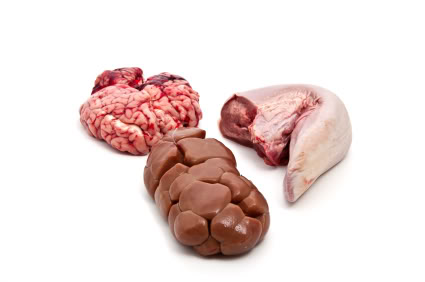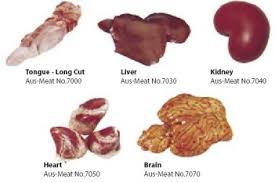The Awe-filled Offal: Not Your Mother’s Humble Pie
Mention “Offal” and you get a reaction of “ah” or “eh” for the misunderstood buzz word. Offal is simply the British name for animal gut, or in the U.S., organ or “variety meats.” In medieval times, deer offal had become so little valued that at the end of a deer hunt would leave the innards or “umbles” would be left to the servants – and so origin of the term eating “humble pie.”
Offals continued to be considered such a bizarre part of the animal they tended to be reserved for the poor. Even today the American processing industry tosses them away, or sells them for animal food or medical devices.
At the same time, European master chefs – now “bad boy” chefs in the U.S, continue to prepare very refined offal dishes, similar to sophisticated counterpart, sweetbreads.
Offals continue to be a favorite on Chef Alain Cohen’s Got Kosher? Café special menu — not for sensational reasons but because they were always popular in Tunisian cuisine. Offals came into widespread use simply because farmers had to use as much of the animal as possible.
And, it turns out that like many “poor people’s foods” (think collard greens in the south), offals are healthy. Fatty, yes, but easily broken down. Offals are also rich in B vitamins (good for healthy blood and nervous system) and protein (promoting the immune system, energy and healthy cell growth), while the liver, heart and kidneys are a good source of iron: 100g of lamb’s liver provides an impressive 7.5mg of iron. Liver is also rich in vitamin A.
Says Chef-owner, Alain Cohen: For us, preparing offals – and kosher meat in general- presents an additional challenge. it prohibits the use of the hind part of the animal, which contains a sciatic nerve, and nerves are not allowed. (it is possible to remove the nerve and there are butchers in Israel known for doing this, but because it is extremely sensitive and difficult, the practice is to not to use this part.) So we get no filet, we get no great roast out of the animal. But we do get the “horns to hoofs.” This requires a lot more creativity.
We still have rich, homey ways to eat the brain, the cheek muscles, tongue, thymus (the fashionable sweetbreads), bone marrow (white matter that’s inside the spine bones, heart, lungs, spleen, kidney, hoofs, and everything inside, including the stomach, esophagus and colon.
At home, we could start with a light brain casserole stew, with boiled and breaded brain “nuggets” and stew them with tomato, garlic, fresh coriander, and other herbs.
The pocket-like spleen can be stuffed with a mince meat made with ground beef, an assortment of spices and the revered combination of garlic, tomato and cilantro. We also insert a hard-boiled egg so that when you slice it, you see the beautiful yellow of the yolk.
Lungs are usually boiled, chopped and put it in a homemade sausage called osban, usually prepared with lung, mint, lots of herbs such as mint, cilantro, etc., rice, harissa, rose petals and a casing made with beef esophagus. One of my favorites is to boil it lungs into a spinach and bean stew called b’kaila. B’kaila, dark and muddy looking in color, is definitely an acquired taste; people either love it a lot, or the opposite – including a split in our own staff.
With the stomach, colon and penis, we clean them very well, and boil them, then slice cut them into chunks and slices and cook that with a delicious harissa, garlic, tomato paste and cumin sauce.
The liver and spleen can be grilled over a flame to “kosherize” because they are so full of blood, (blood being so unkosher). Then we stew it with harissa, garlic, tomato sauce and cumin for fa’ad, a dish prepared with calves or lamb liver. Or you can grind the grilled liver to make into a delicious merquez sausage?, again with the classic harissa, garlic, tomato sauce and cumin.
Tongue is easily boiled, sliced and served with a sauce of harissa, garlic, tomato sauce and cumin. Is there a name for this sauce? you have mentioned it by ingredients 4x now. We can make it into a stew by adding potatoes and capers.
Finally, there are the hooves. So many stews in the style of cholent, b’kaila, and bean dishes are prepared with hooves, including a for Shabbat dish called Kammonia. Sometimes we put it them, or the bone marrow, into the broth of the used for couscous to make it thick.
You can do the cheek two ways. You can use the meat-like cheek muscle, as a protein in dishes. Or you can burn the hair off the cheek skin and grill it, and it’s like a hoof, gelatinous. (?)(and used whole, diced, sliced in what?)
Prepared Tunisian style, bone marrow starts with a long tube maybe 5 to 6 feet long. This is extracted (from the spine or leg or where?), cleaned and grilled. My father’s restaurant had a famous dish with this, called Grillade Blanche featuring slices, diced, grilled? spinal bone marrow or leg bone marrow? and what else?
And did I mention we also eat the testicles? Our dish was bone marrow grilled, slices of sweet bread (thymus) and butter -flied testicles, known as rocky mountain oysters. in America.
A U.S. fad started in the 1980’s when “he-men” began to view “eating disgusting things” to assert their masculinity. “Regional Testicle Festivals” popped up all over the country. It makes me laugh to think about how much we Tunisians were ahead of the game. (It has or has been a custom in China to have specialty restaurants where only different animal penises are prepared)
Because I cannot get kosher bone marrow or testicles here, I replace it them with steak in order to make if the dish interesting – and more “Royale.” And, we can make a combination into a feast, such as with the Grillade Royale and the dish of akoud. At Got Kosher? Café, our popular offals dish, Grillade Royale, has the heart, the heart, liver, spleen, testicle, sweetbread, spine marrow, lamb and merquez sausage.
I love to do special offals menus because the harissa sauce itself is so delicious that even lamb, which is somewhat bland to start with, becomes special extraordinary when it is boiled in this liquid this sauce until the sauce rich and thick. So is tongue, the cheek meat, the brain and the eyes. (Of lamb or all the meats?)
It makes me laugh to think of the grand finale to top everything, one of the most prized dishes, is the head of a sheep. We can do a dinner with this when I find one.
I hesitate to put this on the menu, though, because of our diners’ habits. A little while back, a lady diner complained because I served her a whole fish, butterflied and stuffed, and the eyes were still on it! (Boy do I know those people!)
(www.gotkosher.com)8914 W. Pico Blvd. (1 blk W of Robertson),Los Angeles, CA 90035, 310.858.1920




 Gerry Furth-Sides
Gerry Furth-Sides  Barbara Hansen
Barbara Hansen  Chef-owner Alain Cohen
Chef-owner Alain Cohen  Roberta Deen
Roberta Deen  Jose Martinez
Jose Martinez  Nivedita Basu
Nivedita Basu